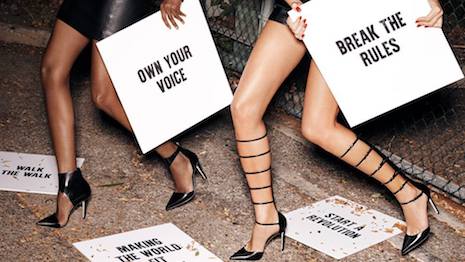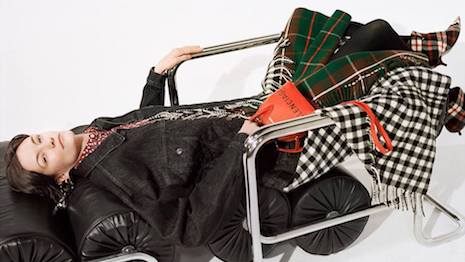In 2019 the global fashion business’ growth is projected to slow to between 3.5 and 4.5 percent, with much of the increase driven by luxury and emerging markets.
Against a backdrop of political and economic uncertainty, about four in 10 fashion executives are anticipating worsening conditions. The State of Fashion Report, coproduced by McKinsey and Business of Fashion, notes that the industry is facing changes that require brands to throw out the old rules to succeed, calling for organizations that are able to rapidly adapt.
"Optimism in the luxury [segment] is aided by their strong performance in 2018 and is fueled by fast-growing Asia-Pacific economies and the continuing boom in global travel," said Achim Berg, senior partner, leader of the apparel, fashion and luxury group at McKinsey and coauthor of The State of Fashion report, Oxfordshire, Britain.
Self disruption plan
The fashion market has exceeded expectations for growth in 2018, with McKinsey anticipating a 4 to 5 percent bump. However, most of this growth is centered at the top, with the 20 biggest brands accounting for 97 percent of total profits.
While fashion remains a growing industry, leaders overall are pessimistic. The report notes that most of those showing optimism were from North America and at luxury houses, with 56 percent of luxury and premium executives expecting conditions to get better.
In 2019, growth is expected to fall from 2018, and a number of economic conditions point to a more challenging environment. Meanwhile, companies are facing greater costs, and economic challenges were the third largest trend mentioned by executive respondents.
Among the causes of uncertainty for fashion businesses is the impending trade war between the United States and China and the ongoing Brexit negotiations. Fashion relies on the ability to move raw materials, talent and completed goods across borders, making potential further disruptions a hindrance to business.
Another trend driving change in fashion is brands adopting sustainability and social causes. Driven in part by demand from consumers, companies are taking vocal sides on controversial debates and supporting initiatives through collections and donations.
For instance, Gucci donated to gun control rally, while Balenciaga has created lines that support Bernie Sanders and the World Food Programme.
 Tamara Mellon aligned itself with the Women's March. Image credit: Tamara Mellon
Tamara Mellon aligned itself with the Women's March. Image credit: Tamara Mellon
Consumers’ desires for sustainability as well as newness are pushing brands to adopt alternative forms of ownership. Younger shoppers are more apt to cycle through wardrobe items, calling for options that allow them to easily recycle and buy affordably.
For instance, Stella McCartney worked with consignment platform The RealReal to encourage resale of its fashions.
"Sustainability is an increasingly important priority for the fashion industry, reflecting rising concerns on the part of consumers and companies about how to alleviate their impact on the environment," Mr. Berg said. "Sustainability for the first time breaks into our survey respondents’ list of the most important challenges, and is evolving from a tick-box exercise into a transformational feature that is ingrained in the business model and ethos of many recent success stories.
"The growing consumer desire for sustainability also drives the shift to new ownership models," he said.
Along with being sustainable, consumers are prompting brands to be more transparent throughout the supply chain, helping to earn back the trust of shoppers who are skeptical. A number of luxury brands were recently called out by a report for their lack of transparency about their environmental and social policies (see story).
About half of millennials say they research brands before buying, making readily available details about production and sourcing key.
Consumer behavior is also changing the typical path to purchase and how shoppers interact with brands. Today, consumers are more apt to get their style inspiration from external sources rather than a brand itself.
Coupled with a need for instant gratification, creating a link between idea and transaction can prove a challenge. Some brands are turning to technology to solve the issue, such as Louis Vuitton’s visual search function that allows a consumer to snap a photo of a look to pull up catalog offerings that match (see story).
 Louis Vuitton's visual search. Image credit: Louis Vuitton
Louis Vuitton's visual search. Image credit: Louis Vuitton
McKinsey also foresees fashion brands meeting consumers’ demand more precisely with technology, allowing production and distribution to be more tailored to audience needs.
The rise of technology and digital savvy shoppers is also forcing brands to “self disrupt,” with about eight in 10 executives naming the need for reevaluation as a top-five trend. In luxury, this internal disruption has led to rebrands such as Burberry and Celine’s makeovers this year, as well as embracing the influence of streetwear.
In the face of up-and-coming and fast growing “challenger brands,” more established players can turn to incubators, mergers and acquisitions and partnerships to help achieve change.
For example, French luxury conglomerate LVMH created an accelerator program focused on supporting innovators in the luxury world at Station F, a large startup campus in Paris. Called La Maison de Startups, the program focused on fostering innovative new startups in the industry while also allowing those startups to communicate and work with LVMH’s brands (see story).
Emerging markets
In 2018 the overall luxury business grew 5 percent to $1.4 trillion, primarily propelled by rising demand from affluents in mainland China.
Luxury sales in mainland China alone grew 18 percent in 2018, according to the 17th edition of Bain & Company's Luxury Study, produced in partnership with Altagamma. The personal luxury goods market is expected to grow at a rate of 3 to 5 percent annually through 2025 for a value of $360 billion (see story).
2019 will mark the year that China becomes a bigger fashion market than the United States, but McKinsey also points to India as a fashion focus for the coming year. With an expanding middle class, the emerging market’s fashion business will total almost $60 billion by 2022, putting it in sixth place.
Consumption in India is set to reach $4 trillion by 2025, according to a report from the Boston Consulting Group, suggesting that luxury brands may do well to invest more resources in marketing and selling in the market.
Within the next few years, India is set to become the third largest consumer economy in the world. With the lion’s share of this growth being pushed by a newly wealthy affluent consumer class, luxury appetites could soar in India by 2025 (see story).
"Far-sighted companies will have to make bold moves in automation and AI, and will disrupt themselves before others do it for them," Mr. Berg said. "Fashion players now need to be nimble, think digital-first and achieve ever-faster speed to market.
"They need to take an active stance on social issues, satisfy consumer demands for ultra-transparency and sustainability and, most importantly, have the courage to 'self-disrupt' their own identity and the sources of their old success in order to realize these changes and win new generations of customers," he said.
{"ct":"fXFjnVZIXVyA+kgAj6fm7FcMFOZdoFj5HBNTkKQAm5ZOYecssf5+fcFEDWe7Qu21RPIncnwgOAMNIPVAW28LC70nGRt20Tzs7Ji433rPB4b5nE+ipZorD3UO38ZIK8EJ\/XE4BZA0LQWEqxGPsE0T01qjpGxwVFEscLFcxSpqp2y3fQm2kEyFj7ntL9HAzjcyeJJ8ZvCw4oGpGr0UGtGyS3m8e\/WzPlM78t0nMPi5kT7XI9SbsYCCSuIfn0L+Q7GiCwT2faKr5+fND\/+Nkg9k\/XiOPoc80yJQDHHxreQDi9ht7IDp5GqJTD6c3Cx\/eKChO9J2hwAvVTzWaiIYEYurNaCoqI4tLOVOgleoxwwmJHSrAoOSrHi9dBWD1cf+xY96tXcLPjfBUtABJ6KvNOMzHGydGGMLg3fXeQHrzT54Xy6NzVSkr+sN6NGPpsf0u7x+SWFUjvahQES\/eFyeQMAOQ8xioikKUMWN52hjiwPLrITcEMiS0sz2Mm3yuYp8VGxIke4Tltuyr1irjoG13p0kRyN\/E41\/UtFwFXNnDo2gMRzPFa2aqgCzrOTosWRTpUmXSqshfuQ62Lsv9xydb4eaK5QVu71eRCP1w0euIVxn0FS+44MeCazgGMJfQh\/9EAMMI4lWqKieD3UApWRv9dInP4GwulMcYk4GOtdOLrXY3eLemcwEq4C9FzJoJRdGdVSXsm13L0dd4g8+\/\/qPuNGF39EFI38Td4FpymYjZtpxhPJtM+sPYC0UFalyS6B1GBxDblLNe1wetTDpwaXqzO3jSZumIMdO0j\/FkuWbTFi9BO73j7vVmPkwzrxMJgxQYoX+4mizGdVno+aHzG2s7I5OkNVw\/0IjiM6gX04vZIHBz\/hqeJgV+pljV4gRjJPNSeJQ\/1Zk0SqEUckuN3I4LJs7APxPvkPtI4yXrY8V5A+Axa4MYhTGc6AUQLiRbPK4JI7dv5wr7\/kMNxIDwzYKvydsi2D2xmQ42mQ0kbzoeTJSrGGOAD6daVbpNf\/zcrPWNotfqxMDyrvE81HZgt09TBQQAhnwX3poiB+Fe8bzz4jdgqWWOQ6XZP0GsiRtHwCpVrqbhHVXKpc+yg\/ROhZq6I5EszRG4PYi82CwSo14xb+UOx1il1jBcNUkQnPhjOs5TqHHjcbeIsa9z+37Z5IEUuA82VaRQG\/aDzUh4SCQ3Rb+gLIgtEL+v5GSCE1lUDW4qIhHLclwRUOzikD5smUaDlwnzmHzm0exQY\/8fOS5dbTFFIbSNdspOj5dKb5pJtQa92zo2PaHPSIMJgWwz9tgQBirxY3r+wey59Qz5BwK1gpByalNmIoURHDdW4SE5FN0BQSAToVGS\/8j3fuUK85X+rQv3MCC+KaZFg+974ISVEqin1cwTGe3+pIIVemch3xenexaZFZOLndxU7IJBXBPtAO+AphF2hmzcdVQp1yCLxdHxeNwi1vKY0Ngq3pJY8w8MawAR\/Up3c8hKo4Je9IGvuv1oRN4+5\/zLcBM8w8dQJUVk8UgtV\/LhlrAtapIDChj0UUfM4xoSns1DPX7c05hoc96tkNf4VlinEKq9JrN4KDjcAfRMDmLCRrOUSLmPb1mV8hIlZYmrIM0q5+5ZhixonO\/59zAdlA5SR1nUDcMd0brBKZQ3yfLo1vV2Mhq8jpCpX+kmpa8Jy\/OQK+fjf5OywTeTxQqYtjEcqNYrgPa2jzbywGgM0QDAyDyYDWr8AARRkahV\/OXGb4CQRABfrZoBfRyYni\/CFbcWHumAnKTrJNZE9BhBTUAqNqaXuIL+xfQSZGNP80j25JkVVPUttst6bRTC4ikQff68Cty0x2uTMHD1zmcboKOuOFa2kfH9gYy5WN2ei\/mNki2V8GAZmu2yJEKihJ0PxrVSLrwNEgD3\/hLvRzMZOiWJBoyKnZflfCfgtiv\/IMqw9SNXpWshxzYOqOOpElUvtbs+fHtrBx7OL2Uy5uv46N6WDPRe\/V6R2snie\/1q0A4TgBMFlHDUYGTEQCNQ2WOmb7NtWFsa+dseGOn+kTzqkDDqk48aNK82bwAOhtMcE26qG1hS86dpF7h8oN8IuLEHfmICAdgD3ym9lIWnvL4ZdlsHNx4vazh5ev17lAjE20dZZD3GsKdIL+S1I+1TuryJFOXS00zusPmD9gnD0gcSpIptbpExZHuWhpsSY1UO7P0oDnoGp6ap1z\/D6UalRxMWKHhiElW4jbPiH3F6HEiAQNqCgJ7M1GzharlsL3ESg7aTYM1Zw+xQUuVJpbI3JTcER\/a56EIWeQNm6y0G2RLeNRVDWqfz2teJusPFlVHUN+6ig7Z8Uwv3SW6MJwPnFF8Hb2VlBiNZayY6kiEzISRuiHgz28fXlUfUKU4kDVuchZkbiZc2uJ9MJlUTDQM8klkqEcr8GmbBUXSdqFYAhBRmtsUDtrfCwJNaSa\/dmGv+jp8n8M\/SbbxU38jshDyS7570uLWG900dC85DeMrgNRmSgNZcyjZiRq4\/KSHmgM1NYC9qunJojWqOZsXWhV2SOoJiLv0KqmK5xk9N6BDMbn0fT3R7RyKQYxwnCMeyLx5\/t025ISd70Mp7G+ZKS\/rYw1sEJpLvc45eljpMmn\/bkZrMQdRcJuacCADFFk91vJl+ESRuaKnPfcGX3RLXEsI7rkas3HMC5CFnJWJmRZS1d4Iw5X54QBW8fznj3ekGt3IVLcZWkiNmaDy76Iren7bTvVx76txhiRDBkKhWUyG+FMUwxwfMbCn3GYFIEyJ12EDkRHdr006O6b+7bdv\/e1zbj3hMzCBtCWdNuufsNXgVwIhyFB9FBHu18oKbvllW52nZ1rSFlDkLimlJ0A3gg40ztgdIStDPU8TJWcCQIvxzvpdm6SBmlCvFkY2LVvBr4dsfJkJ3DPp+Ao9Nz0F6\/sIIfnsv8MFlRuL6oMT3p7A8Lrs0B03R\/4W\/4utaKr75kwrdvPWQ\/kp7qndfqjaacyxt3a9woXlalAioc7fNbZkolcj\/r4ODpUseQyWVc0DfcUuMtXPq06YZieP0Arxz3B8qPkIA2aS64hejAFs85RBpSt49WbiTtmB6IKdiFlA7f6zr6ZD+H1\/c7\/7wHhP0f0Nx1UD+sfqC6jiykAixiEH31RtD6kcPcnwpi83iHFZycqt3Y\/asf7jEVAHAwaAQPacYKbAC5Fz6hag1bTbYAha8KJgtP9QvTkLyNO22wrDw\/QtGSidrY4lfb5ksQVuKSrk4L17AFuETGJbGXjOY\/+qYsgaMMSoDCAgWiNpuTlLLa+vMmioDd9e8iiV9t2AVsrF3U4Alm5sVjsy8Ke9\/wrWtx1MRlCxQFuoPp5Ae+2JZmdeLcxJgMtFmygp+M23xdP\/hy7tx9bFHomr+On9YFjEER\/lOX3lup4ocOaFj7pSfFNv6NvyZVBcrOQ7EIeTc1u4vJoWSO3Jgw3at4ZrULCFX2OrVCF9owEIJx7YXsfYASvm7D9HvYQzQzTV\/cp\/Vuaf3\/1HC8HLQ4gw3HpYDzqwwmL4NaVOH9tWe8Y2LxaItRBAeqtKXizIZ7HNWrzFKGgRf8OqO0u\/j2HCnzyNKQLjIB\/6JhNRDsirzqO\/O4i8HUTZAp8bea8w7Levouy0xljA3NFz3wfo8q3gtdIsywfhzM8T+qPSRb+Px0Imv95CvXwru2q+bYlEqaiAfe8+d\/wwA\/FtHkfZkk7XqAFFP2JItlQ2Ul9GKglTnR3HrHvYghJZLlzBnklvBg\/W0Iip4RMC\/C02nnN\/jgQ7s+EfZ61MsoYSIXpcIQuN7n7eHX3vaRdtkeg9ppfILjH8ajR5N12x+ScM1WIhsZGi72UOFDLdf3+3Afmv0u9KLlMKv61jLGaQRtkpcb0OuxVn8krZa5yGaYQjbLQ6lAjBzwDItxlzV8roV\/PIzD+gY+DKD2GChvM+Bg2O+g6qBBMj9OXeg6EA9SHP5OgQ2sMHbR\/u5jZ1kLUtSKUtqx7DiQ5YaRxKcwRy6Q6+C7En4fdokh6+J0oOYggK+Go24b\/1h5R9twy5JSE1LFttrrb+T16wm0Rfry\/CxDKSyoVw07jAp2gPdKoCpJejk2jxmDhS36fjPQrx2YWneBJK2PiFbOfSAMWMo55Bid+FXS\/kktkE9pYKTfQ2ODfzsh5Grf8BAzZ5LrTAdlwR\/WU6sYI02rVySmNiNO6uwDDhmE06AB1bjk0YRJW\/YZnF3tI5hLI2f3qXB5aCJMk4fNFW6d\/rd9fYbjiGNTCH1jELNUqA+CeftNY9AGY4RS+TyeRYnoYEGlPP\/RJI0UZAJJVi+SYnaBQvh5l5ss7S41h8hP2g2fdBRoQR3yO8GC6QidabXGyLmxhJiSw+1TDTWuObuQ\/xg00AGL2c9yg2lpyaEPnYdXF9dZihXlBMQT34tXKfPzr092AyelT5nRuBTaBdnBreWwccaHvLKr26MMHfDrSYGLqRBlEkul+87JCBuQWycHWpJSpkDSVYvA+Z+yfvbYxbugbxZ5ZstkVsWbCRLpBTqG4KUAnL8v479jVXPK3vvvRd6Z5lLU4yhUR49wEMTzAch0ajcYamTEIryWhAzFmzAvQaidfL6h9LA0EYlSTYrY+Wvr\/hIa8LV3Ghzxjw6ueP\/c0gI99rS\/SK0a30zOzwCWXuLKPrNxeWca+bhER6OhX9R8tsfNiwvlfo\/wwxyVOQEOz70RF+9ezomsxy+OeRhqsxQ7hn90ipyPYRal0Xc8b1\/7kZNVvzfllvfj9cG2x2uBLk7oswoCIMP+mh0QZDbJLiMVlM3Pu74Fbikcm5YbA27GJvAS1Nu9e0VjClez8fBFJOdrsMPfvmt5IDvbG6s1SwOAREr85ejsWtDeeSqTtlCnkc1TdOt+H5aW9xZy5fXdfVq+mvftTINR\/vvQQhms9lRhhJ4S4sUs54W4eV2GBmMwlq9Avits4hJghpBKQPEwqHweqtHLeki2tA9ePytairBdDGMxtWLF6ecdXiUg31n7a5rndqtl3A2StbNT2yjZ2BKIj9kDH3Uhfkd2h5cGtAHD1uTZoQWhZLqmwhk8MfVn66Pdq0tFM7CCNVzuxhTRZGEb0H+rcZuQTIXunUcf7HKpPE6wW+ndjoo5\/Vljl2Mv0sC1j6x6w7Fwb6rdXoKtc3JinZ2x0qKZyLYxlqAVFCsDsZB6mLA6OxTGOajqbCW4lWnvkDO8ApIDHAP+ivhHRhFNhJ3xUL9eOph1HV3c+BgZh7N1kZhN50b08iPBHoAgCfI2Z+SnCFMMC46Pxv8k4zAJV1Gn8bBEZFC8SfVtj8kWAOTpleAk\/0L9xSjD7aeqNIInGrJtAe3htBx9J3yNXqlaqq5FX4YjhZ\/SOD8o3J44cTCf19apzew2YcE4JDArr5FOgOnx5yJQA3XeM9fQGrt9zQs7y6AkxMiW9J8rH9yptdRW3sIbSBoPTtTRfdY6Zu9WZgjfqszL3kb09v1rXtTQCCA8csygiPa56D3tMrZ3snV8bsEmdsdigwifSx8uzPfjjPeF+AM1wkCD11zj15Y4q3ocjOKPeW3cJbvU+S+xzr6E69n7CNdql2CZs+iH\/MQEWx\/LBrxcSL6cTnuXFgjLDx+2iI1eYtGW\/aFCOxXUSxXcFSjCzy+6GIzUMkYps\/ADac07vExVCEGWrHCnXO3Kv0\/glDxHz\/WAwnUma\/EgCEIz\/KqaGQalMw7R4Pu2KPcWUa1ZLVtdwNEhwoD4\/axl2Fn5kytEJ795NGn9JSBeJ9r6mccqWi7t0nkmv\/YT\/VxaH8yy\/gQeaWtBtZ+MOjdqHKr3elVWUeqz8CocIwYd86uCvlI1kkJA91qhgiSsW4kM2ZmuCKApshA69R3596qLIwFDMDDSBiNXMZONBIIrJYdBCraFRPZR6vGK6PiFWAH36X8aGOKSiS2TQKQVSfZkdDoNBOIPagYRnxAMF87aS3f8SzD+\/6QnDLNasXAJAHOpQPY0vhfxM3Xh3WNS0LoCZYbvzPmLGGHx5qxc0xAE6yKAszeUH8t4bV\/jdESlVERB6zj0aoUwZMeQxpt3i35Tzl\/tv9iC2MC6+7NtZO5IJtLMMwEMhBQugnMvWasGs82L+g8WPzapoHSuviQdtuFk8ryfKfoLkfHC4Nr6y533fJ6eMFW9INOjgmcihR9FGdo6GabqjEhQzoLUbY\/5Ne1cb\/zwvkVR7K1C+UHXtKTAWp4awjbAlNjUINzIJIRV\/dFt4596BbvEZqFnzsAhA4+oZPZSYQ\/GOr94psIkVXnRiHm4HFobl\/UF4q\/bE32hh\/pTxpuL6ptCrmZ505rEGegNpWLxOKzQ01ERFVzSEMAFaAa42zfuQxLlT+MgaM0OiemnFUcsTFHPBYZQLv2lVVlwENspqjogKKBE3nCODwAIpYKZocmfwpbc8NkkWK+MPZb\/1dKMuK78d44ybIbm+SBxoMXwhwuOeN7gAkIeIPGH46sqGg2Rcakmj2+1ltAcpm+I4ccFLgpaCyRYzFHUEI3agyaxvHpKCuwicoJpysOD8UyPWJHOPaRRr3FkWrvd8qgNbqO81AS1nXcVPXa1GzdXcA+NwQ0OnRI3VlM9bjoEEjWAlbXJHXxx6qmWGTESVqJdhF80l1uPqBfqFYfQCQvb+P\/w+x0iw+fs37vIas7XBWCS3QE\/jtzwukpsvmu1AHOgAQcJCsHF+YX5PrlzftCZOg7QksacFVZTWv+4CXPW\/B\/Z7cDbaDVRBLGu04jOfFizi8nMgKZYBqb2JCdab8aj4\/3iapY5flP90DpjfwuHQJppyaOmddP0pvad99NqeN\/MDE+i4c2NbxMvOLh2+NPtBlA67nJT7Nz5gMMocPSt7k7o6586J1XbFpBVQRn6YOq3hHJUzwg9X2FFvtQUq6nkKhOpoGGTVrb5Rej8IgG3hhq7+igeNzjmkPPUytY1Z0R3+df5hyWq7OaWOXgvT1qk\/lWRS5WWfvrbfkt2zqgakXh8ETYY0GlBYOgX57jhxakVvTnCLdUcW0B5UGkQtE\/E9t9CC0YvoncFU2iou1O6l30BRD4P0u0yhVeHdf2ZNqTUMalWmnhxnqEozAiESyCURlYUmgNtJYmqA0RybGO5kUDJadlQrA452iTeQSj2VnqiTleOJjUiwMG5ZU8KqDTH8r8ge76p\/KWT6W\/V4NTEx8R0Y5uiU18uSsotzHvyp7XNcY0anm7+YXzuhpz+ZxLjMoFBRhxps\/0WpKA1OqmwVngCcU4Gu8pI6KXzXPUzVHJMJJkLsaOUwsLY7DKIA5Bzf0GVrC\/GvrVNQ2ueYy1pD89BDnspz4i6NaX2buaZFbmjFzMlZChsVtwSz04pDODUArZq1LlCuykOu85n1gbSoZ2Hk5XK36NhvZnoKsRyz7\/IdpI0F2ooJVAAqJzNotZrxZABS7iExPE39X8474v6QfhJvivK4aQ6wbVsDlodpHAWD\/UDHSHnIU6gZVytXbeJrHXRbCKVpZqNZtUBFUx\/IgqqyJk65wlVYhTPxLYXAInQwoEIrvDIQGY4YdM891L0tUXZDizqfyw\/uPvjd\/CC4A0AyF+jkUv6tP8m8mcfa2AD3V1TizaYZM3NYFjCFKKyKt1+SnZr4n6wtBGosG6ZH26itDtN7IvkMS3uOatOrU3t5fm1ZaCDQJZ1AoOcZSsAU6\/mBtGN1iDRqKiNrT++xWnqc6ofEZbeq5SENxbQJfYvg2ahnHMkVfjROETAtM5ETnn2zBEHX5AxmtkW3hLDUrY4q7dk5b2bG3yAOuirpoHjOqZ7vSDwSVZeRD4G+Gn1RFGCeB9U\/55G3VMoBn8wUq5iogF5rs0TksigSiWIpkCH6tX+0cWXHoZxE\/CGvtkEIMtnlGzgCAjyuBdiIVlHqG81ZX3hyyPM01HkrcjW2hINHC8GQDF0f5sR\/Mbi68vKek7MiTPsUWPBQhmfMUG1a+QS4+3\/FAjGCF8XELF9f0w7FsfDcSLtpHD4lLJZA8Y0vtpT83l0RakCmh\/6nnQCOAVjoJUF9TIUTiQEXA\/Qv+seheIdgLOih1oTNzLfpqyk719ShqhxDUSKG0IheOqOInh487eR3EPz06tO6Dpbgy+MIE1IS73OMuGMOhpyqdbSEWMwgXO8r2XXJv0eefNDLRis7fy+udqsyp1opJb963AqjdqZVaX2Xq65OKpBbvbeaN4CBIImsEkkFS5nTLR0lYLXgDQ6MQznJTxhxQ0DThGZo38T3KRYaiCOjkOGm4g63EfKlTF\/uloKXAo2pvIjjNOsASbQ7CRs8JWS44rkQZvKizPm7wpJpek62R6b\/FgkuLHyzPuK6vM1oIMxMAQ9mLrlr0yCqgJiZAEFHMlyXL0M8yAol7o0QluKtUd1i7QrbyGGyBOkUjIissnxKc\/rGF+tpOKsFdoyj+3ZAVri+ClrnJoSh0wlvWV7HDiG0GUHUzZOd07wgdUvQIiHI3pq4qnyEsMsVwjgZ1J\/YP0OiZFLNAslPE\/8493m3HVNN\/p1GtCRBHv3ZCJytnWpIbmu1T8\/\/MsQ5MVjL7r3P42Shz7svHfnc+Rc+XOMeNDiVmV3ntkaETVVIU5kQVfVqUZFrxtzIR3RI4m35ZQsyT00pG5\/3Gl4umtKcKIiu40U0rlKb6mtvhSUpGdP67oyrGXmpMoNrbdLeXAaA0C2s\/oSDs2DsPY0TsEwDVzHghj\/9MHj4YdWXIv1CMznGKk3ovmlejhdxSk8O4LTocdh874ccNDq3HW8w\/ZtgGs73vWQZRmNbT3VybG+Eteydh5If0FfYm5pf5pg50ixSPMZySZc2JlpRzT5JbZDO4bsfZ6rhA0lYKYDqAxUCgu10k1wATVUkiHxBJHzwiR00Doyz5Nh7g7Mw5XIjIM16YMCj4QhF\/hQU1E+uUIH\/fALJKxuNewgkhf\/2F7tub0ws1xDecLrOIyw2QKBwakkJOiFtG96NqByetgcLS6U2UGJwCLUwKg0nZMY9bB01RyLp2nzfKlGus1WzFxUM+5Zgasc\/nkYxxk68YRXamjq2kcCp2ZUubPbQlAKGb9+jGfdjYsSc3oVfVfpV91XfHS8MUwdiEtJtVF1LAJGLklwvr6dvBVhKciJEH4M2xhL0rfvpDuQkVXub8Qhl+ukrek2Pn3Q0ga4yV9M\/iEfO3F\/TG\/CfGyPgIe2ZcSk10oX8DmQTf4JheukQuB2ckDpK11J5u8RXq7foZHkkMQz7UrC3qldl0yEHkwlDtGveS\/35J5zn61tzn4YxfPW85IBcrUNzgw0Vgr8ywI3GLxTZ\/JgM46JPP2Gvxds5xHL1Dx6AUYfHlIvQ5Pzc8Wg9m5OpKuRN5b0oJtw3fepmRSk6MDywmRGCvE9rqFegmFYRVKZWkLx7imw3c3Hu5QJWBCLC6teiSxfz7YFt+yxsD0dJ3io8Rrw+pCw19vBLDvT6M0K9afP6t8glORZttWj+ldDDergQUPfgQPlzBAToarHKEUF4JqEJ0p2JYOmGngfJ9stfhhjrGihPK4hIviWuFydH8wijwbMKeq9EKZw87aGP69S3ZEkmfqXc5w483248k2TIp\/UKQ2yp3mK4c0OeYmGXYbyIEpXE2LvMaLMwZr6gLfb\/rWLCY5+E7VDHamfbD1KvruFhb7Z0k02+XRkfLkJxS94d27xl5+WzcpkTgrXFTZzv3DZm40ojLi25q5YC0OzPDEoAqJ8fTn68gyX5FbYepxJXd2CsTr2gD8B+v3CeR6d6YlJVWpk36bqXy035GGWd\/UndPf7+fnjc87xXBpeJkavCW\/d+tj8tmHP4kLMo39BiOVnwsHKqKhpcQLHaQF9YfTmtnHHOi4mZ0FfPFbIxzU+EoTj\/CFt3fUs5m7GpOMyP8g1B9dB5RRzHbXpV4i5+S5utCwAFDjL9CvqQCFEHZl89zok0HJEKTwnWOrqDtXEkGGlXEnM3XdXI4bk22F2E3iHHeIsnFkg4cLfLe34tXwdGf2jqzQIRHJZZoimkuQq9emQsuCnQJeQI1of9r\/yd5rv9meSRL+iQbuswim8JdJwwsnDjirA1RdR+Y5F1pRpbE4tHTwp1YpaQskvqqPwdFUgV+M1sCAeoxFrYR09tBj0tWPBeMHQih1IfKtE9WckF7AwOi2MA+RKr9EGmJnp5u++U0NJ40S\/EDp0C6e8\/CvVULC3ky1yw6RHDYyFWe\/nYuDWyZkaWlK8K0+DVb5JQll8PSzW1GR04vq8C5BBQVbUHN5PKXt0Y5jya77I2JDP9BFwcfNB24U87QiHk8QUgQ73aiFolGlpO4rDICBdj2JCNcHJ3PEtuHfOAzZuDxj\/r7FuHwlrVxsXPOQszDiwcCCpOwlAFIgSGgG85jj98lvKWiokNkrexQDHhvQKVc\/14FlnxlcJ1TddIxbAm1jUCdNoRj3Qb11U3c6GtfKX2Z8GKfv\/ZOFCPp4xMobfkURPnO\/YnyoHKOr0M3UkpAeHym89Ba2JU06ZJZHfJGjAnOOqp8V3gjaScjzvObBoVq7iwVqXbuCtwxtMZb9alQlJGq0wxkRhQJVbbqvmQbIHaZdzEYjYMbMOJLqC+Pf+OxMek1dTdfNRJca4WeORgOnN\/Xu0xJeY4CV31l0tQV\/fQ47HEkFh\/KZHmDeWEVdJB3mTlU8RIX27gxtYi3Iwx4eTOKOIuf\/pO9SclOMG\/RVlgwCMCJZxjuAPVdgrRAxlKDPeokG6GxuJrPq8TtPsmzOmc9sRBx6czSw0VLzj7IqWQheDfrb3NrNrLZg3+5rnzDiPcNh465TBPNJfF5BT6UwZma9pdPgJk8sk05s1+ATKYeGad9MffOMntgo8+JoncQCR\/aVX4EPtNbpN7hapGC+wz+m0OCgK8Uh0PQU82Q1zYuTwq+esFa75jTt1LmQLok2Kd7wlYwm7G087QBnTJ+h\/zecEWnoaPsJdr9nyyMiai4iNXk7r9D\/xUAQRbCKqbknjwA\/qAzFnQKB1HlekaMBpjccTb30X45VRd9bH3RqFHKrL6TcqvKU0Xvqut0GPr2r1HhB3DOu7YS2UpoV8SobpjgnRJJLT3ap2YTWlA1CC\/RPBoC8LV1uIOwMIQ9BJ01BctqTO0w6KcrcRQXLNgOGR\/y5\/cZMscu92dkWDKx2eHA\/vLuSYRFHBLpSAwb\/kISd0i7TRjHUogRS6lfoU79nFaKBDzyjuIbj11Zt4BtousgJJ3RGQYqaVCsltSgiiQs51qJT3BPS\/0d5oOT+xJlIdWenGbzZ7PySbHHu66gBNGE2YXGzfbIv4RKKAQ0LWjNcgcdXhnK2tfw6JoUoWpVqrHgjMzv1Ny7AE6hD2vzkmYoZkqJaOz5uNzKjsiOH7U44yEUnsY1KlqsO21TcVVH48OUw4R7ekU\/TQOGajgQmO0XsqaqwXXoSZKoBpFvxzqEDxBzVDiD5mWh6PiIBDapySb+oTF1XDxSxX3bl5JNaZ6FZssuYKnKI6j3b5FL7p6kcWJwLtRk85EYmC+c3Sq7sZzm7D5obKFJ7Ilrz\/J+MExv9WDLF4Yhdr9sTVsmHO6eNdGCRWn3VnawnnBsfegT9qelTpql0KJI2i2Gz3Rnv60r2xOqOQpR6RrBn9gt932270iBhLVZj+l4sj3ZI\/n75OBy8WuUj7OsoOCRac+dQWp8wMm6JaT8Y2MV+O2V7NXiSVGI0EBlRtJDgZokcl0Rq4f6Aw9exGOQEw3s9MyvemGqKtY4Y4JZDXW+jsD6YPx9Y9iHZLQgEaCYfMZH33fwJJUAfG3Uobd\/oqfo8FVkHxt\/gAiiB6WRU31Pvz3cXoRK\/O+l3FZBg2SY2CAJNNgWu6ZRwhWavt8iYvNmTZE7rc7+g6w0Wo43AEYIZkZy11DDAM01\/AeqdbGsENejyvtidQjAXmtkAlv0YZLGJlBKjs8wbNMuSEmaJqPZOtRywiLiWA5BcMuT3DUuGktgGbk60SqZJKEH2C5NX1Sk9AuMlGR\/ot804lgHmXG0H9QhnQoC8y+zA68gSW0DeXLlQuqukWEbiYgPM8DqHfgC3Prg9XCuJK8TqHQPGc7OUEireITCc9M\/INxzjywQlSqwslOpaEVwu3TN4KuQ3Yt+bjvYz9MHtpcEIdAGeRjy0sXpviJFM2RtahZByM6XRfKqDyRlY5rNEMhP2t\/etqDH0RsT5+ZRFlha\/OhkefC7miJfKRBY28xvVv4JlNU5FToCW11pTaptWfO7s20mEhDa5VWsRHPpCZVb75BBQ3q7tQCI4PHfdGWJ0V7gw++8ijanZbTHGVo\/GNwhGmT8mIPD0NIGdke6\/rHLArD6X\/wu\/U8pvfRoQkOtxLanr3BOCu5YqGPOI7cgbinamlp3wG4SObvn3tVbArkxXAU+vxz74Gnrwya1o2zJy\/sQt9umCqKUGXgbnvRREbq03GD4REnKK3iN67i2izErE8AFaConmzsUeIDmjPTuZCVtgw4WEUikJQSyIl+m9oLP3ojcoEKnI1SisRVjM9JBJXrmpgXvUktsnGzMNwRuXHTsEzISVbNZVgbBJyioKZgTCIsH5+UZeLV4UarBHZz32y4Lj+qokF9W8gQ8c84GtbuDYwhy7QUgNZsrmHcE\/LpG1zyXwfXmsn5WXoKbbCN31oAagjSfPTqgkbmQ2GdOpTLSOouJMBNN\/5L1JGJ\/xIkJ1+J0SDPJYqxuFUTMD\/kNC4Tc0JStReHaYWEzBLjb8+n7QRKe9TL0syvM5gLSoI66qqqhWCnFn0G4lO+v2gQGkqkJf6hRmUF18sScNt2BJPoFIV6XmPdxI\/FlVg==","iv":"1f02baafec67df4b8b8962d3c48a4385","s":"5aa46521b89f50c2"}

 Luxury brands need to self disrupt to thrive. Image credit: Balenciaga
Luxury brands need to self disrupt to thrive. Image credit: Balenciaga  Tamara Mellon aligned itself with the Women's March. Image credit: Tamara Mellon
Tamara Mellon aligned itself with the Women's March. Image credit: Tamara Mellon Louis Vuitton's visual search. Image credit: Louis Vuitton
Louis Vuitton's visual search. Image credit: Louis Vuitton